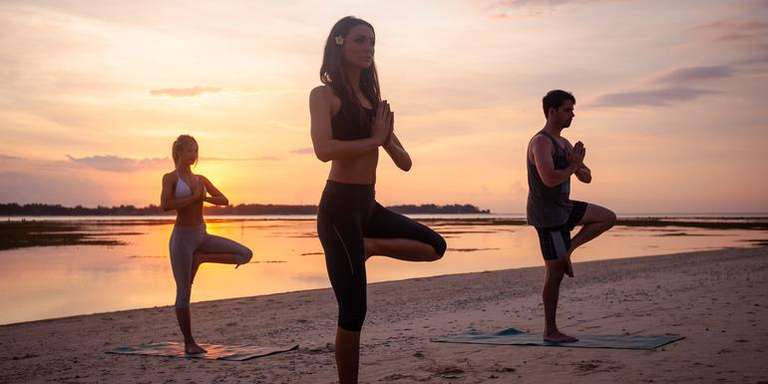10 Indonesian Temples You Must Visit

- Luca Sagerer
- From Austria
- Luca Sagerer
- From Austria
- Fleur Van Dooren
- From Netherlands
- Victoria Luisa Marsiaj
- From Switzerland
1. Borobudur
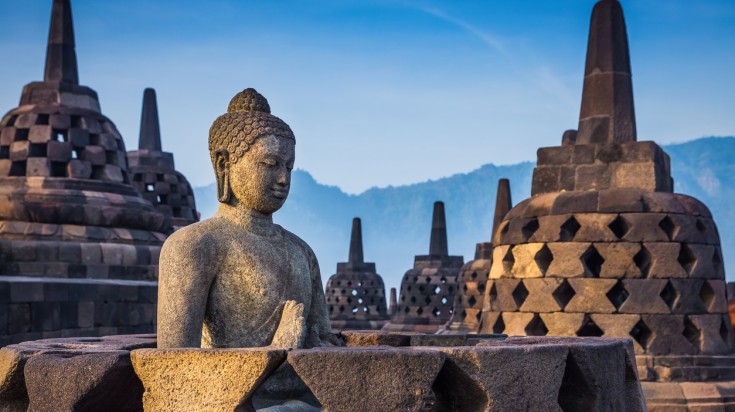
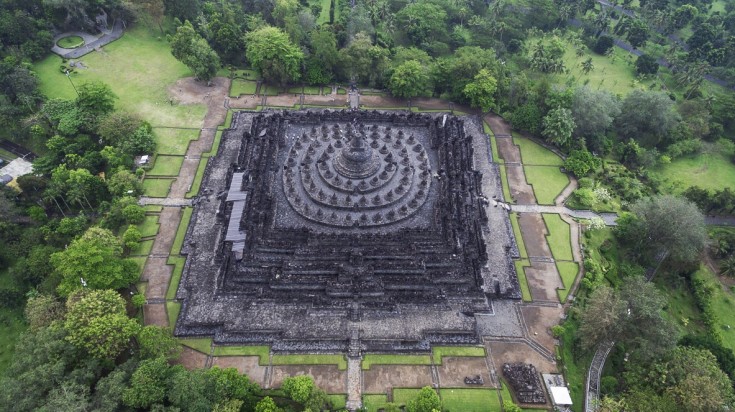
Set in Central Java, Borobudur is the world’s largest Buddhist temple and by far the most well-known Buddhist temple in Indonesia. Built on an epic scale, Borobudur has survived nearby Gunung Merapi’s frequent volcanic eruptions, terrorist bombings and the massive 2006 earthquake. Towering high above the iconic green rice fields this monumental structure puts Indonesia’s other temples in the shade with its sheer scale. Built in the 9th century, this massive construction featured a stepped pyramid design covered in ornate carving. Borobudur’s expansive central dome is crowned by 72 openwork stupas each containing its own statue of Buddha, set atop five concentric square terraces adorned with serried statues. Today, this majestic building is a UNESCO World Heritage site.
Location: Central Java
Opening time: 6:00 am to 5:00 pm
Tips:
- Sunrises are very special. Make an early morning trip to view the spectacular scenery.
- Avoid weekends and public holidays as it can get very crowded.
- Bring water and wear comfortable clothes and shoes to climb up the temple.
2. Prambanan
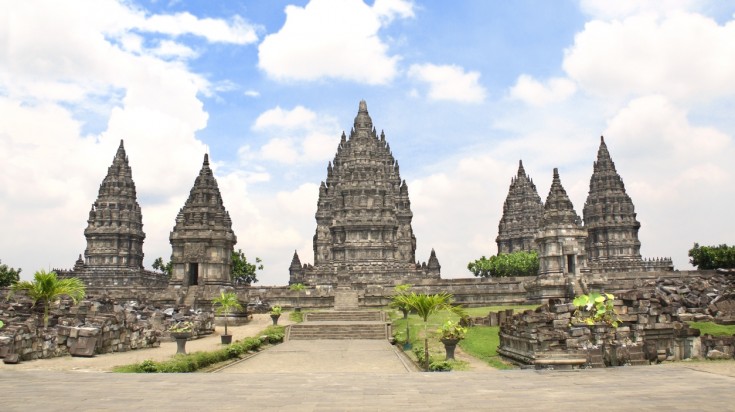
The Prambanan or “many priests” temple is the largest Hindu temple in Indonesia. Prambanan was built in the year 850 and today the temple complex is being reconstructed. One of the most imposing features are the scattered ruins of Prambanan’s 224 outer temples. As visitors enter the heart of the temple complex, they discover eight major and eight minor temple clusters. Their elaborately carved stupas praise Trimurti, a manifestation of Brahma the Creator, Vishnu the Preserver and Shiva the Destroyer.
Location: Yogyakarta, about two hours East from Borobodur
Opening time: 6:00 am to 5:00 pm
Tips:
- Visit early mornings or late afternoons to avoid the tourist crush.
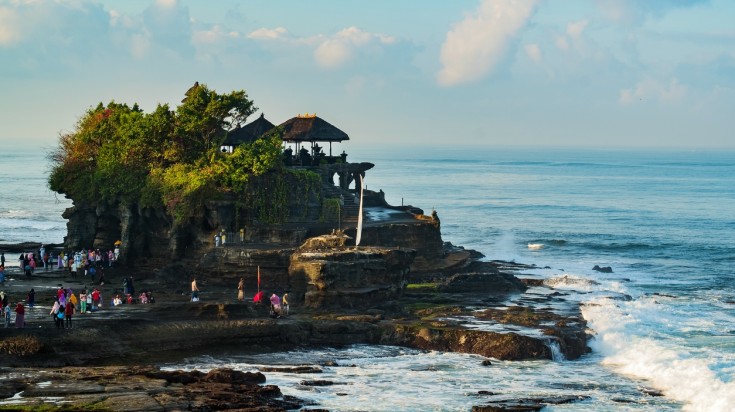
Sculpted into a picturesque rock outcrop jutting out into the sea, Purah Tanah Lot temple is visited by thousands of visitors each year. This visually striking construction is the western-most point of Bali’s six major cardinal temples. The temple perches on a self-contained island and can only be reached during low tide by foot. This beautiful temple is possibly the most photographed location on Bali, particularly its delightful sunsets.
Location: Sanur, Bali
Opening time: 7:00 am to 7:00 pm. However, the temple can only be reached during low tide so check on the temple’s accessibility before heading out.
Tips:
- Try to time your visit to coincide with the sunset.
- While entering the temple is not allowed to visitors, one can receive blessings from the shrine at the bottom of the rock.
- As is the custom, after you've received the temple blessings, prepare to donate a small amount back to the temple.
4. Pura Ulun Danu Beratan

Set on Bali’s magical Lake Bratan, its cool air and drifting fog imbue this temple with a mystical atmosphere. Pura is a Balinese word, which means temple. Nestling among peaks, the Ulun Danu Beratan temple has been serving Bali’s local Hindu residents since 1633. The temple was designed to praise Dewi Danu, the goddess of lakes, rivers and water.
Location: Lake Bratan, Bali
Opening time: 8:00 am to 6:00 pm
Tips:
- Aim to arrive early in the morning after sunrise when the lake is at its calmest and the reflections of the temple and mountain on the lake is at their best.
- You can’t miss out on Pura Beratan while on a trip to Bali. Check out the Beautiful Bali tour and enjoy all the highlights of Bali including this floating temple.
5. Uluwatu Temple
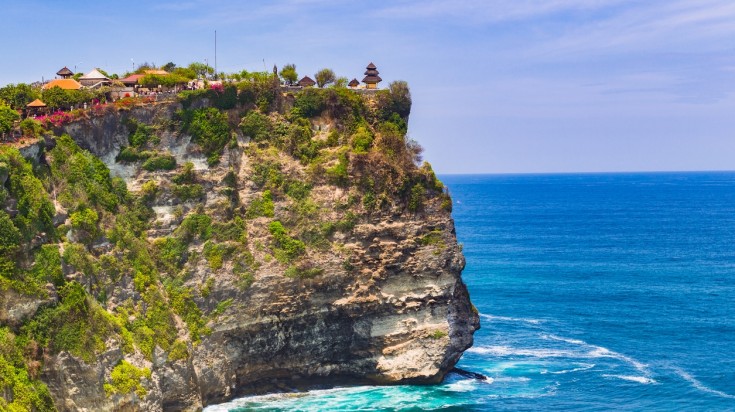
This temple located at the edge of the 70 meter high cliff is as famous for its stunning sunsets as it is for the large group of monkeys that inhabit the place. It is said that the temple was expanded from a small shrine to a much larger temple area in the 11th century by a Javanese sage. The temple has stunning architecture similar to other Hindu temples in Bali and is one of the six principle temples of the island believed to protect the island from evil. The temple also displays Balinese Kecak and fire dance at sunset.
Location: South Kuta, Bali
Opening time: 9:00 am to 6:00 pm
Tip:
- Be careful of the monkeys, they are known to snatch bags, sunglasses and purses from visitors.
- Visit the temple during sunset to enjoy the traditional dance and sunset simultaneously.
6. Kalasan Temple
Dating back to the 8th century, the Kalasan temple stands 34 meters all on a base measuring approximately 45 suare meters. Ancient ecclesiastical sculptures, statues and motifs decorate the temple’s polygonal structure set on a rectangular base. Each of the temple’s cardinal points features gates and connecting stairs embellished with a figure of giant Kala-Makara, a mythological, half-terrestrial creature. The niches adorning its exterior wall are elaborately decorated with images of Kala and other divinities depicting the Svargaloka, celestial palace of the gods.
Location: Kalasan, Yogyakarta
Opening time: 6:00 am to 5.30 pm
Tip: The temple is located on the way to Prambanan temple, so it is possible to drop by at this temple on the way to Prambanan.
7. Mendut Temple
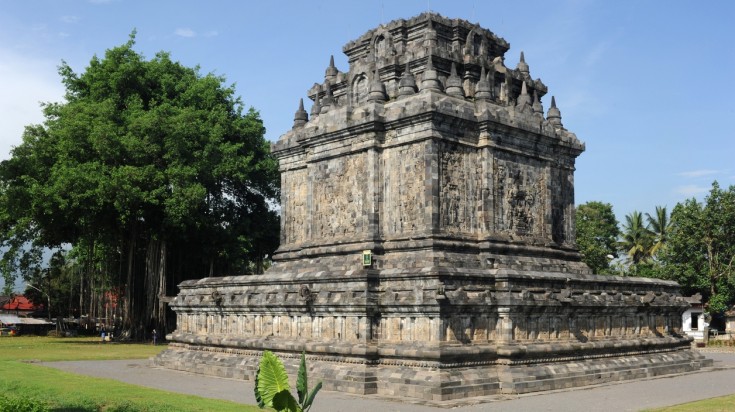

One of a trio of temples set around the Borobudur complex, this Buddhist temple was completed in the 9th century, making it the oldest of the Borobudur area temples. Rediscovered by the Dutch in the 19th century, it was the first major temple to be completely restored. Featuring a square base, the temple is decorated with statues together with relief wall carvings. Inside the central temple, are three large statues depicting Dhyani Buddha Vairocana, Boddhisatva Avalokitesvara and Boddhisatva Vajrapani.
Location: Central Java
Opening time: 7:00 am to 7:00 pm
Tip: If possible, time your visit for a summer full moon that usually falls in May when priests start their trek to Borobudur from Candi Mendut for Buddha’s birthday.
8. Cangkuang Temple
This compact mystical temple is the only Hindu temple found in West Java. Named after the tropical pandan tree, this 8.5-metre-high candi was built in the 8th century and sits on a 16.5-hectare site on the edge of a picturesque lake. Highlights include a 62-centimetre all statue of Shiva sitting inside the temple’s central room and also an Islamic tomb located three metres south of the temple. To reach the temple you need to ride on a traditional bamboo raft called a getek and get across a small lake.
Location: West Java
Opening time: 7:00 am to 5:00 pm
Tip: Visit the museum located nearby to see relics from the ancient temple at display.
9. Pura Besakih
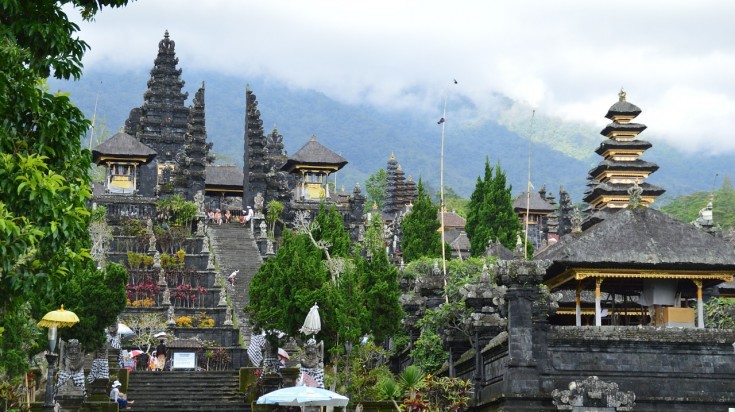
Located in the slopes of Mount Agung, Pura Besakih is one of the largest Hindu temples in Bali. It consists of 23 temples inside the compound with Pura Penataran Agung being the most important shrine. Besakih is also known as the Mother Temple of Bali because of its importance in Bali’s Hindu culture. The oldest temple, Pura Batu Madeg was built in the 8th century with other shrines being gradually built over the years. Pura Besakih has had several restorations following an earthquake in 1917 and volcanic eruptions from Mount Agung.
Location: Bali
Opening time: 8:00 am to 5:00 pm
Tip: Visit early mornings and evening to avoid the large crowd of tourists during the day.
10. Gedongsongo Temple
The Gedongsongo temple is a small complex of nine Hindu temples built from volcanic stone on the slope of Mount Ungaran in central Java. The scenery and serene mountain vibe makes it a memorable experience. The first Gedong Pitoe contains seven of the temples. Discovered by the legendary English explorer Raffles in 1804, the nine temples in the complex were originally built during the early period of the Medang Kingdom, which controlled Central Java during the 8th and 9th centuries. Five temples known as Gedong I through V have been renovated. Gedong III, IV and V were the subject of the most recent renovations, which lasted from 1977 to 1983. The remainder of the site is largely in ruins.
Location: Ambarawa, Central Java
Opening time: 7:00 am to 5:00 pm
Tip: Combine your visit with a trip to the local Museum Isdiman.
One of the most outstanding examples of Indonesia’s cultural heritage is its evocative, sprawling Hindu and Buddhist temple complexes. These majestic Indonesian temples are architectural marvels that is home to some awe-inspiring stone architecture, statuary, carvings and motifs. So, channel your inner serenity and prepare to be amazed by their lingering spirituality.


